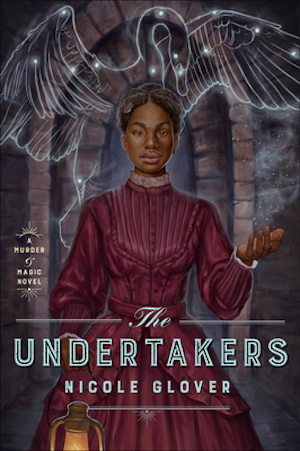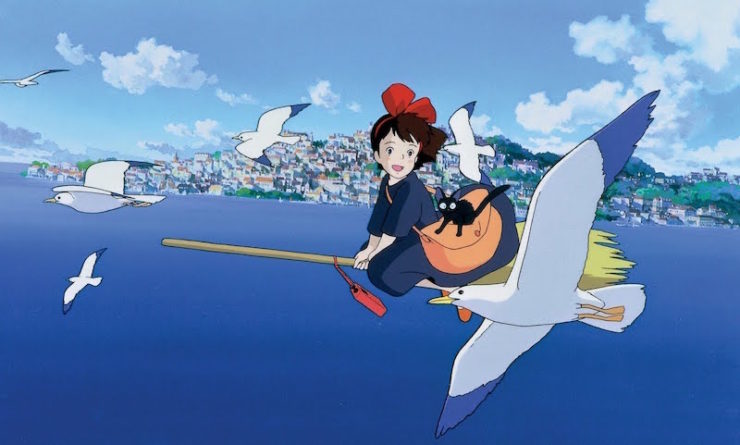Always a popular archetype, the witch has been having a surge of popularity these days. From Bewitched to the Sabrina comics to The Worst Witch to Little Witch Academia, there’s so much witchy media to consume to your heart’s content. As I’ve always been a fan of witches, this is something I’m happy to see. But even with all the stories centering on or about witches, I’m often reminded that Kiki’s Delivery Service is one of my favorite stories about being a witch.
It’s more than a residual affection for black cats from my Sailor Moon obsession, or even my interest in flying. Kiki’s Delivery Service makes magic and its witches both mundane and magical at the same time.
The stakes of the movie itself are low—it’s a coming of age film at its core, but it has a gentle charm and way of making the magic seem to fit right in the world. Kiki’s ability to fly the broom is given no special treatment. Throughout the film, Kiki just hops on the broom much like one would do a bicycle. And even the scene of her arrival to Koriko, her flying is framed as whimsical. Throughout the film there’s no sense of flashiness to her flying, except near the climax—and even that moment is only magical because of her character arc.
These are the things I find myself greatly appreciating in the film. Witches in a great deal of media are often seen as an outlier. They belong to a secret or hidden society, and stick out like sore thumbs when among the mundanes in the world. However in the world of Kiki, witches are no secret. There aren’t many witches, granted, but witches are part of the community. This is made clear in the opening scenes with Kiki’s mother making a potion for a customer as well as Kiki’s father calling up neighbors and friends to come see Kiki off. Kiki’s flying is well known in her village as well as her penchant for bracing against trees as she ascends into the air. When she leaves home, a neighbor even laments “I’ll miss the sounds of those bells.” Even when Kiki arrives in the city of Koriko, her being a witch is unusual only because witches have not been in the city for a couple of generations. This is a world that knows magic, and while not everyone is familiar with it, it’s hardly a grand secret. Kiki being a witch with a smattering of magic is treated no differently than someone who knows how to ride a unicycle while playing bagpipes.
The idea of magic (and witches) being well known to the world is something I rather like. In a lot of fantasy media, particularly in the West, we see witches, magic users, and other supernatural beings attempting to blend in by hiding their magic and talents from the mundane world. This becomes even more true when the world of the story is fairly close to our own. The reasons given often boil down to the fact that the wider world is not ready for magic. This means that magic is seen best tucked away, belonging to a world of its own instead of part of something much greater. The magical world becomes a world which exists alongside the modern day world, separate and known only to a few, and where the consequences of letting the mundane find out about it are high.
It’s only really in second-world fantasy stories, that you’ll see magic very much known in the world, and even then it’s often seen as suspicious. This can be as extreme as in The Fifth Season in which its magic users are not only ostracized but used as literal tools, to stories where magic is found mostly in a lone witch who is shroud in mystery and misconceptions like The Girl Who Drank the Moon. A great deal of classic high fantasy, from the big names to obscure titles, prominently feature magic users who are outcasts, distrusted, or disliked. So much that I’m often surprised when I do read something where magic users aren’t being actively pushed out of society.
Buy the Book


The Undertakers
To bring it back to Kiki, I love how the magic of the world is a natural fit. And being a natural fit allows for other conflicts to be explored – from the coming of age elements to the often talked about metaphor for creative burnout. With magic as just one more element of the world, it allows a closer look into Kiki’s characterization and relationship with her magic.
Kiki is figuring out what it means to be witch, and what type of witch she wants to become. She isn’t ashamed of being a witch, but she does feel limited and wants to explore more options in contrast to her mother’s more traditional view of witchcraft. When she mentions wearing dresses other than traditional witch’s black, it is less about her wanting to be a non-magical girl and more about being able to do common things alongside her witchy things. With this view of tradition there are quite a few scenes showcasing old and new: the juxtaposition of Kiki flying around with radio dangling from her broom, or the new sign of her eponymous delivery service at the end of the movie including the silhouette of the streetsweeper’s brush. This arc, and the nuances of her story would not have had such a presence if the usual tropes of magic ostracization or suspicion were utilized. Those external conflicts would rob us not only of the wonderful character work, but takes a little joy about a world with touches of magic of it. A joy and whimsy that Kiki’s Delivery Service delivers in spades.
I often wonder why other stories of magic choose to draw a line between mundane and magical. Well, I know the reason: it’s an easy way to create dramatic tension. But I love to see more stories set in the “real world” where magic is a predominate and commonplace trait. I think there are more interesting things to do narrative wise with characters, plot, and world building. Like with anything, I know there’s quite a few already out there. What are some that you know about?
Nicole Glover works as a UX researcher in Virginia. She believes libraries are magical places and problems seem smaller with a cup of tea in hand. Her life outside of books include bicycles, video games, and baking the perfect banana bread. She is the author of The Conductors and its sequel, The Undertakers, forthcoming in November 2021. She can be found at her website.










